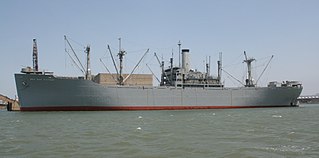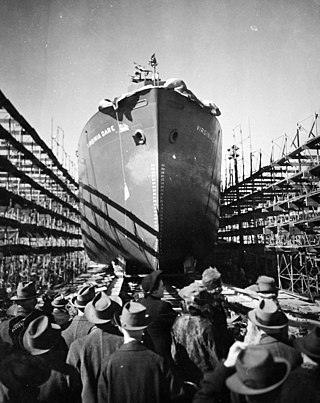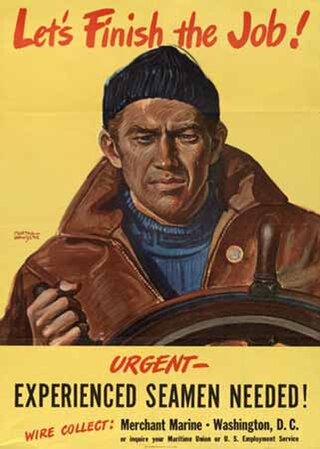
Liberty ships were a class of cargo ship built in the United States during World War II under the Emergency Shipbuilding Program. Although British in concept, the design was adopted by the United States for its simple, low-cost construction. Mass-produced on an unprecedented scale, the Liberty ship came to symbolize U.S. wartime industrial output.

The United States Merchant Marine is an organization composed of United States civilian mariners and U.S. civilian and federally owned merchant vessels. Both the civilian mariners and the merchant vessels are managed by a combination of the government and private sectors, and engage in commerce or transportation of goods and services in and out of the navigable waters of the United States. The Merchant Marine primarily transports domestic and international cargo and passengers during peacetime, and operate and maintain deep-sea merchant ships, tugboats, towboats, ferries, dredges, excursion vessels, charter boats and other waterborne craft on the oceans, the Great Lakes, rivers, canals, harbors, and other waterways. In times of war, the Merchant Marine can be an auxiliary to the United States Navy, and can be called upon to deliver military personnel and materiel for the military.

Stier was an auxiliary cruiser of Nazi Germany's Kriegsmarine during World War II. Her Kriegsmarine designation was Schiff 23, to the Royal Navy she was Raider J.
The Merchant Marine Gallant Ship Citation is an award of the United States Merchant Marine. The award is presented as a bronze plaque to vessels, with officers and crew being awarded a ribbon bar to denote the award. Both United States flagged vessels and foreign flagged vessels are eligible for the award.

The Pacific Steamship Company was a US freight and passenger shipping company that operated between 1916 and 1936. The company was formed by the merger of the Pacific Coast Steamship Company and the Pacific-Alaska Navigation Company and was a direct competitor to the Alaska Steamship Company in the Alaska-Seattle shipping business. Pacific Steamship Co. owned and operated The Admiral Line and The Admiral Oriental Line. American Mail Line worked with the Admiral Oriental Line.

The action of 6 June 1942 was a single ship action fought during World War II. The German raider Stier encountered and sank the American tanker SS Stanvac Calcutta while cruising in the South Atlantic Ocean off Brazil.

SS Marcus Daly was a liberty ship built by the Kaiser Shipyards at their Permanente No.1 yard at Richmond, California, and launched on 24 July 1943.

The SS Baton Rouge was a cargo Victory ship built during World War II under the Emergency Shipbuilding program. The Baton Rouge (MCV-846) was a type VC2-S-AP2 Victory ship built by Bethlehem-Fairfield Shipyards. The Maritime Administration cargo ship was the 846rd ship built. Her keel was laid on June 21, 1945. She was launched on August 22, 1945, and completed on September 24, 1945. The 10,600-ton ship was constructed for the Maritime Commission. The American Export Line and later the Isthmian Steamship Company operated her under the United States Merchant Marine act for the War Shipping Administration.

The SS Bucknell Victory was a Victory-class cargo ship built during World War II. The Bucknell Victory was a type VC2-S-AP2 victory ship built by Permanente Metals Corporation, Yard 2, of Richmond, California. The Maritime Administration cargo ship was the 728th ship built. Her keel was laid on December 27, 1944. SS Bucknell Victory was an armed cargo ship, named for Bucknell University in Pennsylvania, one of 150 educational institutions that had Victory ships named after them. She was built in just 70 days, under the Emergency Shipbuilding program for World War II. The 10,600-ton ship was constructed for the Maritime Commission.
SS John Bascom was a Liberty ship built in the United States during World War II. She was named after John Bascom, a professor of rhetoric at Williams College from 1855 to 1874, and the president of the University of Wisconsin from 1874 to 1887.
SS Nathanael Greene was a Liberty ship built in the United States during World War II. She was named after Nathanael Greene, Continental Army general famous for his service in the Southern theater of the American Revolutionary War. She was operated by the United States Lines under charter with the Maritime Commission and War Shipping Administration.

SS Virginia Dare was a Liberty ship built in the United States during World War II. She was named after Virginia Dare, the first English child born in America, who disappeared along with the rest of the Roanoke Colony.

SS Cuba Victory was built and operated as Victory ship class cargo ship which operated as a cargo carrier in World War II, Korean War and Vietnam War.

USNS Norwalk (T-AK-279) was the first in her class, a Fleet Ballistic Missile Cargo Ship, which was launched as a World War II commercial Victory cargo ship SS Norwalk Victory under the Emergency Shipbuilding program. The Norwalk Victory was acquired by the U.S. Navy in 1963.

USNS Furman (T-AK-280) was a Norwalk class Fleet Ballistic Missile Cargo Ship, which was launched as a World War II commercial Victory cargo ship, the SS Furman Victory under the Emergency Shipbuilding program. The Furman Victory was acquired by the U.S. Navy in 1963.

USNS Marshfield (T-AK-282) was a Fleet Ballistic Missile Cargo Ship, which was launched as a World War II commercial Victory cargo ship SS Marshfield Victory under the Emergency Shipbuilding program. The Marshfield Victory was acquired by the U.S. Navy in 1968.
South Atlantic Steamship Company was the passenger and cargo founded in 1928 in Savannah, Georgia that ran the South Atlantic steamship Line. They started by chartering foreign ships to run the lines in tramp trade. Later scheduled cargo services was added to the line. In 1958 the company was taken over by United States Lines. In 1961 United States Lines closed the Atlantic steamship line and renamed the Atlantic steamship line ships. US homes ports were: Jacksonville, Florida, Savannah, Wilmington, North Carolina and Charleston, South Carolina. Main foreign ports were: London,Liverpool and Manchester UK. At its peak, it operated 60 ships during World War II. During World War II the South Atlantic steamship line was active with charter shipping with the Maritime Commission and War Shipping Administration. During wartime, the South Atlantic steamship line operated Victory ships and Liberty ships.

SS Skagway Victory was a Victory ship built for the United States during World War II. She was launched by the Oregon Shipbuilding Corporation on June 21, 1944, and was completed on July 15, 1944. The ship's US Maritime Commission designation was VC2-S-AP3, hull number 116 (V-116). She was built in 64 days under the Emergency Shipbuilding program. The Maritime Commission turned her over to a civilian contractor, the Alcoa, for operation until the end of World War II hostilities. She was operated under the US Merchant Marine Act for the War Shipping Administration.

World War II United States Merchant Navy was the largest civilian Navy in the world, which operated during World War II. With the United States fighting a world war in all the world oceans, the demand for cargo and fuel was very high. Cargo and fuel was needed around the world for the United States Navy, United States Army, United States Marine Corps, United States Army Air Forces, United States Coast Guard and the support of the allied nations of the United States. American steamship companies chartered ships from the Maritime Commission and War Shipping Administration to meet the demand. Many United States Merchant Marine ships were newly built in the Emergency Shipbuilding Program, other ships were older World War I ships that were put back in service, or private ships acquired under Emergency war requisitions. The Merchant Navy operated in the Pacific War and European war. Over 200 US Merchant ships took part in the D-day Normandy landings. To make a Normandy breakwater Harbor, called Mulberry harbour, 33 merchant ships were sunk 1,000 yards from shore. Some of the ghosts merchant ships used were damaged and others were deemed too old.
North Atlantic & Gulf Steamship Company was founded in New York City on February 13, 1932, by George V. Reilly, William M. Stevens, and David H. Jackman. The president of North Atlantic & Gulf Steamship Company in 1932 was Charles Walter Ulsh. North Atlantic & Gulf Steamship Company's treasurer and vice president was Clifton Waller Barrett. Charles Walter Ulsh and Clifton Waller Barrett founded the ship broker firm Ulsh & Barrett. Charles Walter Ulsh invited and patented a skid platform pallet for shipping. His United States patent #US1934389A is used for a stackable and nested skid platform.











